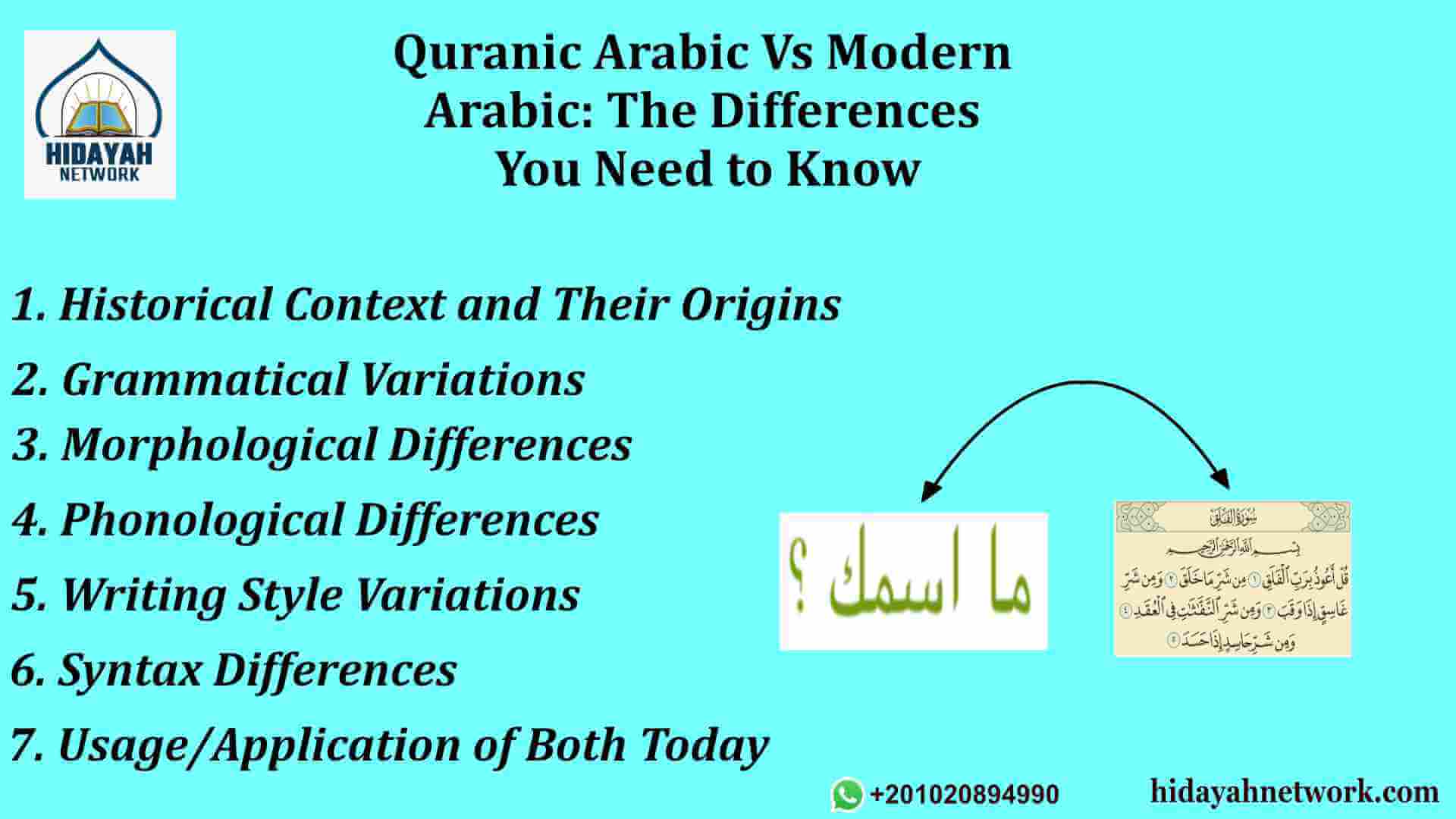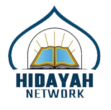Many Arabic speakers ponder, “How different is Quranic Arabic from modern Arabic?” It’s a valid question, as these two forms of the language, while related, exhibit distinct aspects. Their disparities begin from their historical backgrounds, phonological nuances, morphological distinctions, and more.
Thus, recognizing these differences is pivotal to avoid confusion. In this article, we’ll delve into the fundamental distinctions that set Quranic Arabic words apart from their modern counterpart, providing you with the clarity and insight needed to understand the diverse nature of the Arabic language confidently.
Table of Contents
ToggleWhat is Quranic Arabic
Quranic Arabic refers to the specific form of the Arabic language in which the Quran, the holy scripture of Islam, was revealed. It holds a unique and revered position in the Arabic linguistic world.
This type of Arabic encompasses the linguistic features, vocabulary, and grammatical structures found in the Quranic text, as it existed during its revelation in the 7th century. Quranic Arabic serves as the medium through which the divine message of the Quran is conveyed to the Prophet Muhammad (PBUH). Hidayah Network offers a great opportunity to learn Quranic Arabic online for kids and adults. Start today with a free trial!
What is Modern Arabic
Modern Arabic, often referred to as Modern Standard Arabic (MSA), is the contemporary form of the Arabic language widely used for written and formal communication across the Arab world today.
It represents the language’s evolution and adaptation to the demands of modernism, serving as a unifying linguistic standard that bridges the various regional dialects spoken in Arabic-speaking countries.
7 Differences Between Quranic Arabic and Modern Arabic
1. Historical Context and Their Origins
Quranic Arabic and Modern Arabic have distinct historical origins that significantly influence their characteristics. Quranic Arabic originated during the 7th century when the Quran was revealed to the Prophet Muhammad. It reflects the linguistic features of that era and serves as a preserved record of the language during that time.
Modern Arabic, on the other hand, has evolved over the centuries and continues to adapt to contemporary needs. Its development is influenced by interactions with other languages and cultural changes, making it more flexible and dynamic.
2. Grammatical Variations
Grammatical variations between Quranic and Modern Arabic are noticeable and crucial in distinguishing the two. Some specific grammatical structures and rules in Quranic Arabic differ from the more standardized grammar found in Modern Arabic. Understanding grammatical variations is to learn Arabic to understand Quran.
To further exemplify this difference, consider the phrase “قُلْ هُوَ اللَّهُ أَحَدٌ” (Qul Huwa Allahu Ahad), which is from the Quran and means “Say, He is Allah, [Who is] One.” In this sentence, the verb “قُلْ” (Qul) is in the jussive form, emphasizing the command to “say.” In Modern Arabic, such jussive forms are less prevalent, and the sentence might use a different verb form. This grammatical variation highlights how Quranic Arabic adheres to unique grammatical rules not commonly found in Modern Arabic.
3. Morphological Differences
Morphological differences between Quranic Arabic and Modern Arabic encompass changes in word forms, roots, and nominal patterns. Quranic Arabic maintains a more archaic morphological structure, often utilizing word forms and roots that have evolved in Modern Arabic. Let’s consider the root “كتب” (k-t-b), which means “to write.”
In Quranic Arabic, you’ll encounter forms like “كَتَبَ” (kataba) for the past tense, whereas Modern Arabic might use “كَتَبَ” (kataba) as the standard form. This divergence in morphological patterns showcases how Quranic Arabic retains older word forms and roots, adding a layer of complexity for learners transitioning from Modern Arabic.
4. Phonological Differences
Phonological differences refer to variations in pronunciation and phonemes between Quranic Arabic and Modern Arabic. Quranic Arabic has preserved certain phonological features that have evolved in Modern Arabic pronunciation. One notable difference lies in the pronunciation of certain letters.
For instance, in Quranic Arabic, the letter “ق” (qaf) is pronounced with a distinct guttural sound. In contrast, it may be pronounced differently in many Modern Arabic dialects, often as a “g” or “k” sound. These phonological disparities can pose challenges for learners aiming to recite Quranic verses accurately.
This phonological difference highlights the unique phonetic characteristics of Quranic Arabic, which learners need to master to recite Quranic verses and understand their pronunciation intricacies correctly.
5. Writing Style Variations
Quranic Arabic and Modern Arabic exhibit distinct writing styles that reflect their respective periods and linguistic purposes. As found in the Quran, Quranic Arabic employs a highly structured and poetic writing style characterized by its use of metaphors, allegories, and rhetorical devices.
To provide a clear example of this distinction, consider the Quranic verse: “وَمَثَلُ الَّذِينَ كَفَرُوا كَمَثَلِ الَّذِي يَنْعِقُ بِمَا لَا يَسْمَعُ إِلَّا دُعَاءً وَنِدَاءً” (Surah Al-Baqarah, 2:171). This verse metaphorically compares disbelievers to those who “cry out to one who hears nothing except a call and a cry.” Such figurative language is common in Quranic Arabic but is rarely seen in the straightforward prose of Modern Arabic, which would typically use simpler language to convey the same message. So, it is necessary to learn Arabic to read Quran.
6. Syntax Differences
Syntax differences between Quranic Arabic and Modern Arabic relate to their sentence structures and arrangement of words. Quranic Arabic often employs a unique and intricate sentence structure to convey its intended meanings effectively.
It might use anastrophe (changing the typical word order) for rhetorical purposes. In contrast, Modern Arabic follows a more conventional word order and sentence structure, making it easier to comprehend for contemporary readers.
7. Usage/Application of Both Today
Quranic Arabic and Modern Arabic have distinct applications in contemporary contexts. Quranic Arabic continues to be of paramount importance in the Islamic world, serving as the language of the Quran, the holy book of Islam. It is primarily used for religious study, recitation, and interpretation.
Scholars and students of Islam need a deep understanding of Quranic Arabic to grasp the nuances of the Quranic text accurately. It also plays a pivotal role in religious rituals and prayers, ensuring the correct recitation of verses from the Quran.
In contrast, Modern Arabic is the language of everyday communication in the Arab world. It is used in various domains, including education, media, business, and government. Modern Arabic is a lingua franca, enabling people from diverse Arabic-speaking backgrounds to communicate effectively.
Which One is the Easiest to Learn: Quranic Arabic Or Modern Arabic?
Learning Modern Standard Arabic (MSA) is easier for beginners than for Quranic Arabic. MSA is more widely used in everyday communication, has a standardized grammar and vocabulary, and is the form of Arabic taught in educational institutions. It also provides a foundation for learning regional dialects. On the other hand, Quranic Arabic involves unique vocabulary, grammatical structures, and pronunciation differences specific to the Quran, making it more challenging for beginners without prior exposure to Arabic.
Hidayah Network is a reputable platform that has consistently assisted individuals in learning Quranic Arabic and MSA through experienced teachers. Their dedicated instructors provide structured and comprehensive lessons on how to learn Quranic Arabic, catering to learners of all levels, from beginners to advanced students.
By offering a supportive and immersive learning environment, Hidayah Network has successfully facilitated the acquisition of Arabic language skills, helping students navigate the complexities of both Quranic Arabic and MSA with confidence and proficiency.
Final Words
Quranic Arabic and Modern Arabic are distinct yet interconnected facets of the Arabic language. While Quranic Arabic preserves the linguistic heritage of the Quran, Modern Arabic adapts to the needs of contemporary society. Understanding their differences and similarities is essential for anyone interested in Arabic.
Whether you aim to explore the depths of Quranic literature or engage in everyday communication, recognizing the unique characteristics of each form empowers you to navigate the rich diversity of the Arabic language and culture with clarity and purpose.
Frequently Asked Questions
You can read the Quran if you know Modern Standard Arabic (MSA). MSA provides a foundation for understanding Quranic Arabic, but there are differences in vocabulary, style, and certain grammatical structures that may require additional study to comprehend the Quran fully.
Classical Arabic is not the same as Modern Arabic. Classical Arabic refers to the language used in ancient texts like the Quran and classical literature, while Modern Arabic encompasses the contemporary, spoken, and written forms used in everyday communication.
The difficulty of learning Modern Standard Arabic (MSA) varies from person to person. It can be challenging for some due to its complex grammar and pronunciation. However, many individuals successfully learn MSA with dedication, practice, and effective learning resources.










